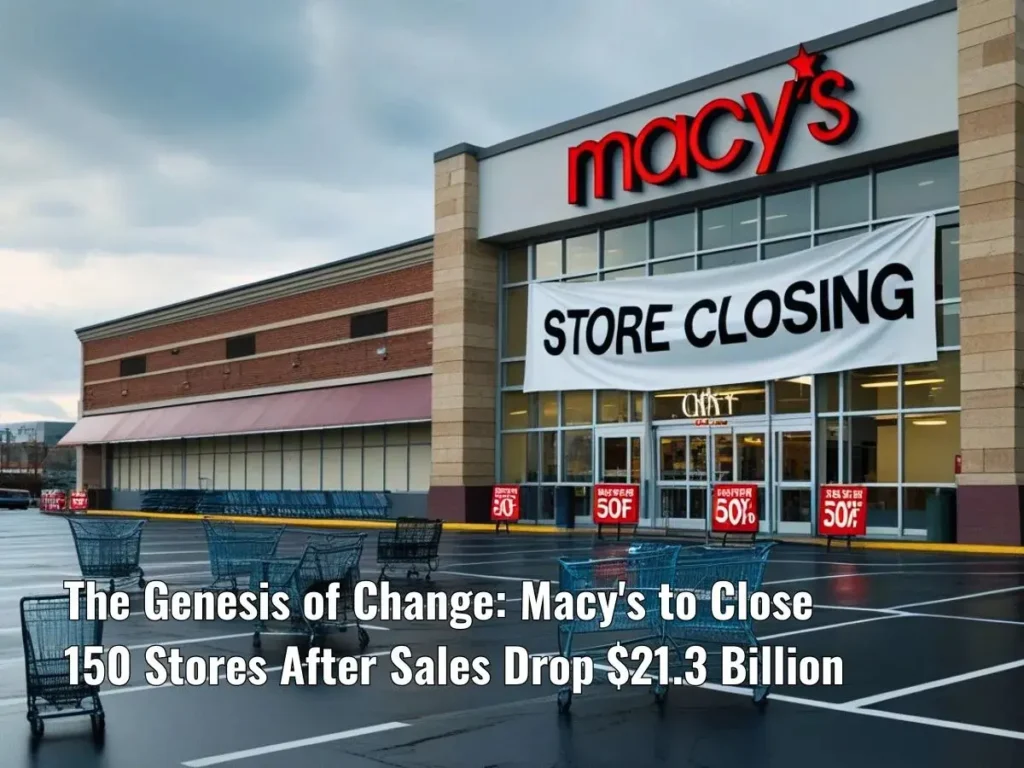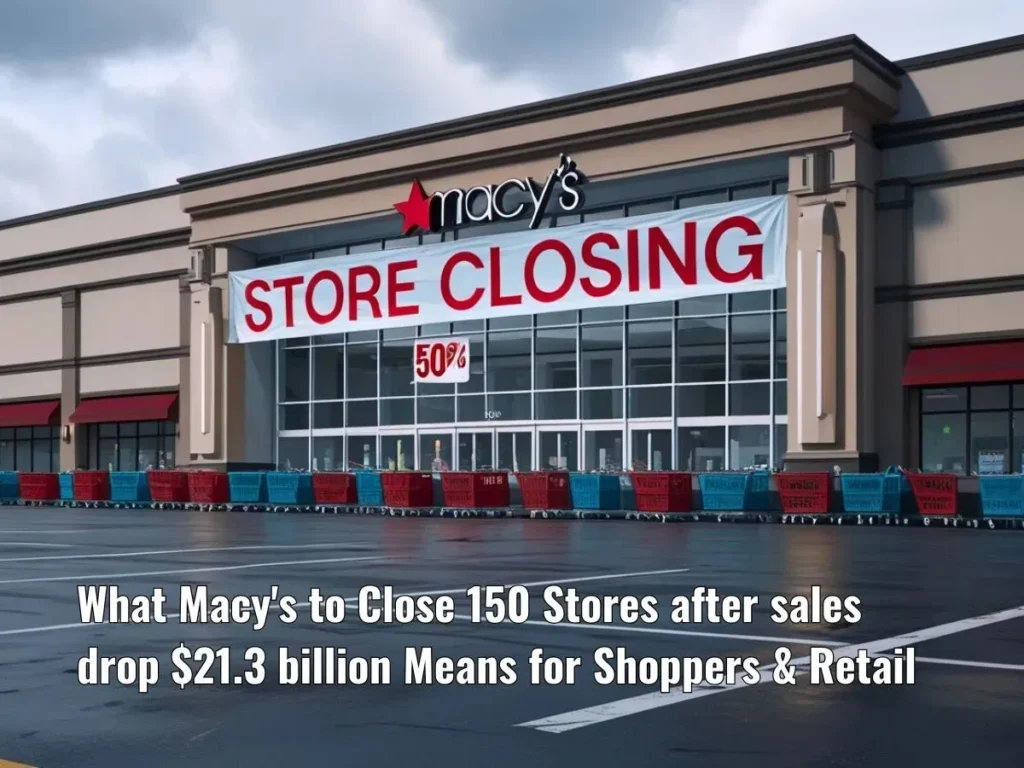Introduction
Macy’s, a grand old name in American retail and an emblem of national commercial culture for over 150 years, is at a crossroads. At a time when the very nature of retailing is being redefined on this prime stretch of commercial real estate, that name, long associated with grand parades and generations of shopping memories, is going through its own most significant transformation. The bold decision by Macy’s to close 150 stores after sales drop $21.3 billion is not simply a downsizing.
Instead, it is a strategic reset, a challenging but necessary moment for the brand and the wider, more turbulent retail landscape at present.
The action marks the start of Macy’s “Bold New Chapter,” a strategic initiative aimed at resetting the Macy’s brand and reinvigorating the business as the company looks to the future in an evolving retail landscape.
The Genesis of Change: Macy’s to Close 150 Stores After Sales Drop $21.3 Billion

To understand the drastic measures Macy’s is taking, we need to examine the forces transforming retail and its financial situation.
Many are wondering, “why does Macy’s to Close 150 Stores After Sales Drop $21.3 Billion?” And this figure of a $21.3 billion sales drop is the scariest of challenges.
It indicates significant decreases in net sales over time. Macy’s, for example, recorded a 5.5% decline in revenues for 2023.
More recently, net sales for Q1 2025 were $4.6 billion, with a comparable sales decrease of 2.0%. It is this continuing act that explains why Macy’s is struggling.
There are obvious reasons for this financial change:
- The Insane Exploitation of E-commerce: Digital retailing has revolutionized the way people shop, prioritizing convenience and online pricing.
- Loss of Mall Traffic: This change has resulted in a sharp decrease in the number of visitors to traditional malls, where Macy’s is located.
- Costly Operation of Legacy Stores: Older, larger stores are expensive and no longer profitable.
For instance, the 150 stores closing are a quarter of Macy’s physical space, but only 10 percent of its sales. This is an indication of how poorly they are doing.
Thus, these strategic closures are a brave acceptance of the fact that what worked in the past must be adapted to remain relevant.
“A Bold New Chapter”: How Macy’s Plans to Rebound After Sales Drop $21.3 Billion
The “Bold New Chapter” strategy takes on an existential battle for Macy’s.
Guided by a three-year plan that the chief executive, Tony Spring, said was intended to focus on investing in the business, rather than solely on closures, the company is on a path toward relying more on profitable sales growth.
Optimizing Store Presence
A critical part involves maximizing Macy’s current stores and investing dollars in “go forward” locations. Approximately 350 Macy’s stores will undergo major upgrades to enhance the customer experience.
That means more displays, in-market offerings, and better service with additional staff. From the 2/14 “First 50” pilot stores (now the “Reimagined 125”), we already have proof of incremental sales and customer satisfaction numbers in Q1 2025.
The move by Macy’s to shutter 150 stores after a $21.3 billion sales decline directly feeds into investment in the best-performing stores.
Accelerating Luxury and Digital Growth
Macy’s also holds a strong hand in the luxury market. They’re going to expand Bloomingdale’s (with 15 new stores by 2026) and Bluemercury (with 30 new locations and remodels).
Meanwhile, Bluemercury experienced its 17th consecutive quarter of comparable sales growth in Q1 2025, a trend that continues to demonstrate its popularity.
In light of the digital transformation, Macy’s has placed a significant emphasis on a robust omnichannel retail experience.
This applies to both the internet and physical retailers. You need to invest in an updated supply chain (I would recommend using generative AI) and a scalable tech platform.
Additionally, Macy’s will also sell off assets and plans to net $600-750 million by 2026 to redirect it into growth initiatives.
Impact & Implications: What Macy’s to Close 150 Stores After Sales Drop $21.3 Billion Means for the World
Macy’s to Close 150 Stores After Sales Drop $21.3 Billion: The company’s change is more than a cliché. It reveals profound changes happening throughout the retail industry. The episode illustrates numerous things.
First, it’s a testament to the accelerating trajectory of retail consolidation. Those days of large, what I call formulaic, standard, or general department stores being the main draws for every mall are over.
For retailers, a physical store has to be good for something. What they need to do is provide consumers with interesting, experiential opportunities for shopping rather than just selling merchandise.
Macy’s approach of investing in fewer, better stores accomplishes this. It is hoping for more engagement and a more targeted shopping experience. Second, the closures will affect malls and communities.
- Ripple Effect: A large store’s exit can trigger so-called co-tenancy clauses in leases. This allows other tenants to walk away, leading to a chain reaction of vacancies and financial hardship for mall owners.
- Repurposing Challenges: While some neighborhoods may experience a reprieve, others must find new uses for massive retail spaces. It is a situation reminiscent of those encountered by other department store chains, such as JCPenney and Neiman Marcus. But they, too, had their bankruptcies and shrank.
For consumers, the changes could signal a more focused and elevated customer experience in the still-existing Macy’s stores. Still, physical shopping options will be more limited in some areas.
On the whole, Macy’s gutsy gambit is a powerful testament to the future of physical retail. It shows companies have to adjust constantly.
Timeline & What Comes Next
Here’s the phased closure and transformation plan:
| Year | Stores Closing | Focus |
| 2024 | ~50 stores | Clearance events, lease exits |
| 2025 | ~50–60 stores | Small-format “Market by Macy’s” |
| 2026 | Remainder (~40) | Full shift to profitable outlets |
In addition, Macy’s will:
- Open smaller, more nimble store formats
- Upgrade the app and website
- Turn to luxury lines, like Bloomingdale’s or Bluemercury
These efforts are designed to reduce costs and increase customer satisfaction in the long term.
What Macy’s to Close 150 Stores after sales drop $21.3 billion Means for Shoppers & Retail

For the millions of devoted Macy’s customers, understanding these changes is crucial.
What Macy’s Store Closures Mean for Shoppers
“What Macy’s stores are closing in NY?” How to find out soon! It would be a daunting task to keep an updated, real-time list of virtually every store in the nation so that I won’t attempt that here, either, but some key New York stores confirmed for closure include:
- Fordham Place (Bronx)
- Brooklyn (Fulton Street)
- Melville Mall (Huntington Station)
- Queens Place Mall (Elmhurst)
- Mall at Greece Ridge (Rochester)
- Sunrise Mall (Massapequa)
For the latest information on the status of specific locations, visit the company’s official Macy’s website at macys.com and refer to the store locator and customer FAQ sections.
And yes, many people also ask, ‘Where is the largest Macy’s in the world?’ This is the iconic Macy’s Herald Square store in New York City, which is conspicuously not one of the 150 stores closing.
At 1.1 million square feet of selling space, it still serves as a flagship, albeit one that is receiving investment and serves as a linchpin to Macy’s future vision.
For bargain hunters, clearance sales at the affected Macy’s locations have been steep, with prices sometimes cut by as much as 70% on select merchandise.
That creates an opportunity to save big before the doors are shut. Please note that each event typically enforces a “no refunds” or “all sales final” policy.
The Revitalized Shopping Experience
On the “go-forward” stores, shoppers can expect a refreshed shopping experience. The stores will feature an enhanced product offering and focus on individualized service. This is an effort to rebuild direct connectivity with customers.
Lessons for the Retail Industry
Businesses and stakeholders in the larger retail sector can learn from Macy’s shift in strategy. It illustrates the pressing need for ongoing innovation. It also demonstrates the peril of adhering to outdated business models.
Macy’s luxury brands are thriving, and its dedication to offering a seamless online and in-store customer experience represents areas of growth that other retailers should consider.
Regardless of their size, these sites ought to be investigated. Having the independence to right-size physical stores, build out technology, and understand customer needs is no longer a luxury.
It’s necessary for sustainability in the long run. The era of the general, large department store is over. It is being replaced by more specialized, efficient, and experience-driven retail.
And so that is the answer to the question, “Why is Macy’s closing?” It’s all part of a strategic survival and growth plan.
Is This the End for Macy’s? Not Quite.
Contrary to headlines, Macy’s is not going away. Instead, it’s evolving:
- Store count will continue to decline, but the stores that do remain will be stronger
- The spotlight will be on higher margin products such as beauty and luxury
- Flagships strive to secure a brand image
This turnabout is similar to other department stores’ strategies, such as Nordstrom’s move to upscale and Target’s success with small-format stores. Macy’s is adapting for the long haul, not hunkering down.
Conclusion: A Bold Path Forward for Macy’s
Bold move by Macy’s to close 150 Stores After Sales Drop $21.3 billion. A decline in sales marks a significant shift in the retail industry. This is not a discrete exit, but a brave retreat from the battlefield.
Macy’s paths to growth are by offloading weak assets and investing in promising outlets, store bases, labs, and digital initiatives.
And yet its Bold New Chapter is a fascinating case study of adaptive leadership in a dynamic market, and something that’s helping write the future of department stores.
Ready to step into the world of retail transformation? Thoughts? Or subscribe for more.
FAQs
Why is Macy’s to close 150 Stores After Sales Drop $21.3 billion?
Macy’s to Close 150 Stores After Sales Drop $21.3 Billion, an effort to cut costs and redirect resources to its top-performing digital and luxury businesses, following a period of brutal sales declines.
What do Macy’s store closures mean for shoppers?
Shoppers can expect clearance sales at closing stores, as well as ongoing loyalty benefits, but will have to adjust to fewer local stores and a more streamlined online shopping experience.
Which Macy’s stores are closing in New York?
New York Macy’s stores that are going out of business include Fordham Place, Brooklyn (Fulton Street), Melville Mall, Queens Place, Mall at Greece Ridge, and Sunrise Mall.
Is Macy’s Herald Square, the world’s largest Macy’s store, going to close?
No, Macy’s Herald Square in NYC isn’t closing; it’s a flagship store and a large part of Macy’s future.
Why is Macy’s struggling, leading to these store closures?
Macy’s is grappling with changing consumer preferences, which have shifted more towards online shopping, weak mall traffic, and rising expenditures related to the bigger and underperforming stores.








